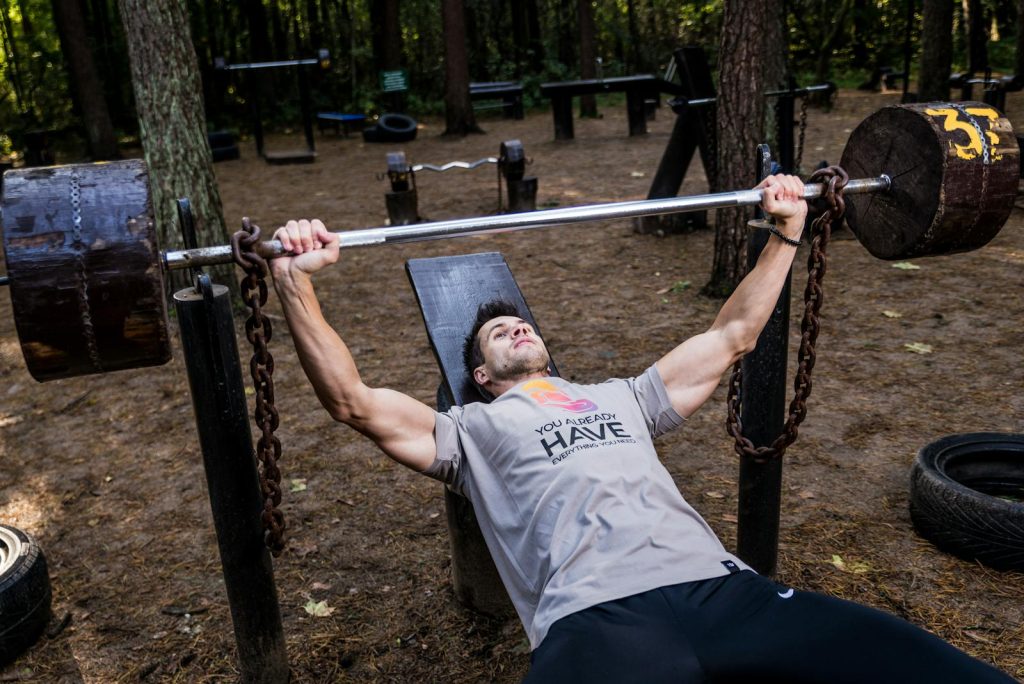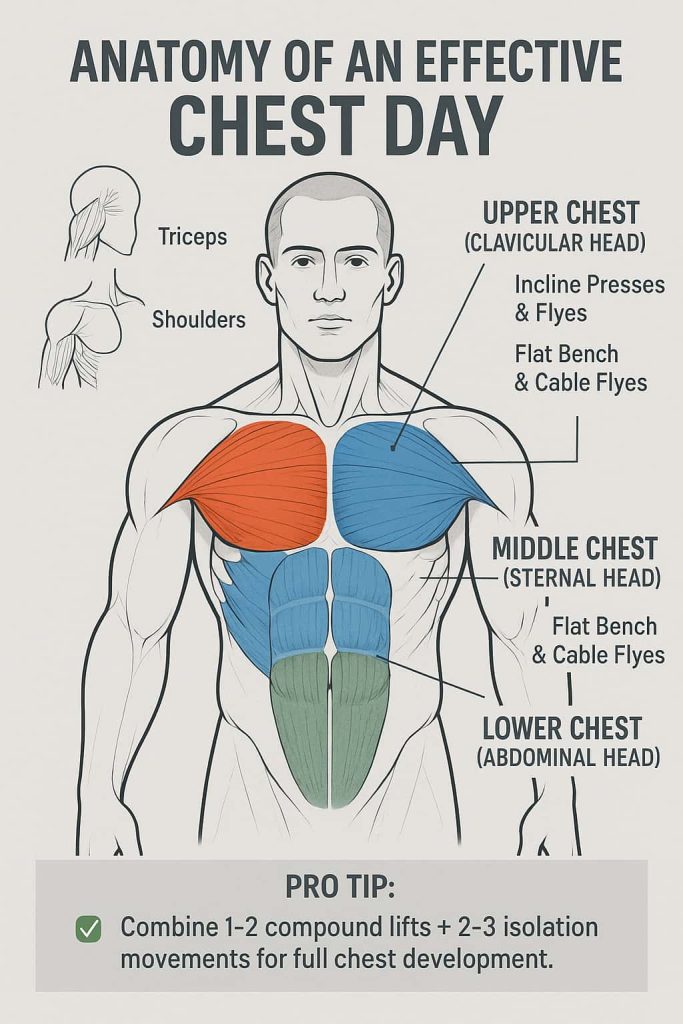Building a powerful chest isn’t just about endless bench presses — it’s about strategic exercise selection, form, and intensity. The best chest day workouts combine compound strength movements and targeted isolation exercises to maximize growth, definition, and symmetry.

Understanding how to structure your chest day ensures you hit upper, middle, and lower pecs for complete development — boosting both strength and aesthetics. This guide covers the 16 best chest exercises based on recent EMG studies.
Anatomy of an Effective Chest Day
Before diving in, here’s how your chest training should be structured:

- Upper Chest (Clavicular Head): Incline presses and flyes
- Middle Chest (Sternal Head): Flat presses and cable flyes
- Lower Chest (Abdominal Head): Decline presses and dips
- Stabilizers: Triceps, shoulders, and serratus anterior
✅ Pro Tip: Combine 1–2 compound lifts + 2–3 isolation moves each session for optimal growth.
16 Best Chest Day Workouts
Below are the top exercises categorized for balanced hypertrophy and strength.
1. Barbell Bench Press (Flat)
Why it works: Known as the “king of upper-body lifts,” the flat barbell bench press activates more muscle fibers across the entire chest than any other movement. It builds raw pressing strength while stimulating both the middle and lower pectoral regions.
Muscles worked: Pectoralis major (sternal head), anterior deltoids, triceps brachii, serratus anterior.
How to do it:
- Lie flat on the bench with feet planted firmly.
- Grip the bar slightly wider than shoulder width.
- Lower the bar to the mid-chest slowly, keeping elbows at 45°.
- Press the bar back up while squeezing your chest at the top.
Trainer Tip: Don’t flare your elbows or bounce the bar off your chest — control every inch for best results.
Sets/Reps: 4×6–8
2. Incline Dumbbell Press
Why it works: EMG data shows incline pressing activates up to 30% more upper chest fibers than flat pressing. This exercise sculpts the upper pectorals for a fuller, lifted appearance.
Muscles worked: Clavicular head of pectoralis major, anterior deltoids, triceps.
How to do it:
- Set the bench at a 30–45° incline.
- Hold dumbbells at shoulder level, palms facing forward.
- Press the weights up and slightly inward, focusing on chest squeeze.
- Lower under control until arms are at 90°.
Trainer Tip: Use a lighter weight for better control and full range. Avoid excessive incline angles (above 45°).
Sets/Reps: 3×8–10
3. Decline Barbell Press
Why it works: The decline angle shifts the focus to the lower chest — crucial for achieving that rounded, complete pec look. It’s also shoulder-friendly for many lifters.
Muscles worked: Lower pectoralis major, triceps, anterior delts.
How to do it:
- Lie on a decline bench and grip the bar slightly wider than shoulders.
- Lower to the bottom of your sternum.
- Press up under control without locking elbows.
Trainer Tip: Don’t overload — prioritize full motion and mind-muscle connection.
Sets/Reps: 3×8–10
4. Dumbbell Chest Fly
Why it works: Provides maximum stretch and peak contraction to sculpt inner and outer pecs — ideal for improving definition.
Muscles worked: Pectoralis major, anterior deltoids.
How to do it:
- Lie flat on a bench holding dumbbells above chest.
- Open arms in a wide arc until elbows are parallel to shoulders.
- Return to start while keeping a soft bend in elbows.
Trainer Tip: Focus on the stretch and squeeze — not the weight. This is a precision move, not a power lift.
Sets/Reps: 3×10–12
5. Cable Crossover (High to Low)
Why it works: The cable’s continuous resistance maximizes time under tension, helping sculpt the lower chest and improve the “chest tie-in” near the abs.
Muscles worked: Lower chest, anterior delts, triceps.
How to do it:
- Set pulleys high above shoulders.
- Step forward, elbows slightly bent.
- Pull handles down and across your torso in a hugging motion.
Trainer Tip: Squeeze and hold for one second at the bottom of each rep.
Sets/Reps: 3×12–15
6. Incline Cable Fly
Why it works: This move keeps constant tension on the upper chest through both stretch and contraction — a superior version of dumbbell flyes for many lifters.
Muscles worked: Upper pectoralis major, anterior delts.
How to do it:
- Set the cables low and hold handles in each hand.
- Bring arms upward and inward toward your upper chest.
- Slowly return to the start position under control.
Trainer Tip: Visualize your hands moving in an arc, not straight lines, for a deeper squeeze.
Sets/Reps: 3×12–15
7. Push-Ups (Weighted or Standard)
Why it works: A functional staple that strengthens the chest while engaging the core, shoulders, and triceps — essential for overall upper-body stability.
Muscles worked: Pectoralis major, triceps, core stabilizers.
How to do it:
- Place hands slightly wider than shoulder width.
- Lower body until elbows are at 90°, keeping a straight line from head to heels.
- Push up explosively.
Trainer Tip: Add a weight plate or resistance band to progress overload.
Sets/Reps: 4×AMRAP
8. Machine Chest Press
Why it works: Offers consistent resistance without needing stabilization, allowing you to safely push heavier loads for hypertrophy.
Muscles worked: Pectoralis major, triceps.
How to do it:
- Adjust seat height so handles align with mid-chest.
- Grip handles and press forward smoothly.
- Slowly return until elbows are slightly behind torso.
Trainer Tip: Focus on controlled negatives — slow reps build muscle faster.
Sets/Reps: 3×10
9. Dumbbell Pullover
Why it works: A forgotten classic that stretches the chest and expands the rib cage — enhancing the V-taper aesthetic.
Muscles worked: Pectoralis major, lats, serratus anterior.
How to do it:
- Lie perpendicular to a flat bench with only shoulders on the surface.
- Hold a dumbbell above chest, arms slightly bent.
- Lower it behind head until chest stretches, then pull back up.
Trainer Tip: Keep movement slow and controlled to avoid shoulder strain.
Sets/Reps: 3×12
10. Dips (Chest Focus)
Why it works: Bodyweight powerhouse that hits the lower chest and adds mass to the inner chest line.
Muscles worked: Lower chest, triceps, front delts.
How to do it:
- Grab parallel bars, lean torso slightly forward.
- Lower until elbows hit 90°, then press up strongly.
Trainer Tip: Don’t go fully upright — stay leaned forward to target the chest.
Sets/Reps: 3×8–12
11. Smith Machine Incline Press
Why it works: Provides stability while letting you lift heavy with reduced injury risk — perfect for isolating the upper chest.
Muscles worked: Upper chest, shoulders.
How to do it:
- Position bench at a 30° incline under the bar.
- Lower to upper chest and press upward in a smooth arc.
Trainer Tip: Keep wrists straight; focus on slow lowering.
Sets/Reps: 3×8
12. Pec Deck (Machine Fly)
Why it works: Offers constant tension, isolating the inner pecs for a full, defined look.
Muscles worked: Inner pectoralis major.
How to do it:
- Sit with back against pad, arms at chest level.
- Bring handles together slowly until they nearly touch.
- Return without letting weights rest.
Trainer Tip: Use a 2-second squeeze at the midpoint to maximize fiber recruitment.
Sets/Reps: 3×12–15
13. Squeeze Press (Dumbbell Variant)
Why it works: Combines pressing and isometric contraction — forcing your pecs to stay engaged through the entire motion.
Muscles worked: Inner and mid-chest.
How to do it:
- Hold two dumbbells pressed together at chest level.
- Push them upward while maintaining constant pressure.
Trainer Tip: Use moderate weight — tension is more important than load.
Sets/Reps: 3×10
14. Landmine Chest Press
Why it works: Ideal for lifters with shoulder issues. The angle targets upper pecs while reducing joint stress.
Muscles worked: Upper chest, anterior deltoids, triceps.
How to do it:
- Load one end of a barbell into a landmine attachment.
- Hold the bar at chest height and press upward at 45°.
Trainer Tip: Engage your core to prevent leaning and keep elbows slightly tucked.
Sets/Reps: 3×10
15. Floor Press
Why it works: Reduces range of motion to protect shoulders while focusing on mid-chest and triceps lockout strength.
Muscles worked: Mid-chest, triceps, shoulders.
How to do it:
- Lie on the floor with dumbbells or a barbell.
- Lower until elbows touch the floor, pause briefly, then press up.
Trainer Tip: Perfect for those with shoulder discomfort during full bench presses.
Sets/Reps: 4×8
16. Reverse Grip Bench Press
Why it works: EMG studies reveal this activates 25–30% more upper chest fibers than traditional grip.
Muscles worked: Upper pectoralis major, triceps.
How to do it:
- Grip bar underhand (palms facing your head).
- Lower bar to upper chest and press upward.
Trainer Tip: Start with lighter weights — this movement requires grip adaptation and wrist control.
Sets/Reps: 3×8
How to Structure Your Chest Day Workout
| Goal | Focus | Ideal Set/Rep Scheme |
|---|---|---|
| Strength | Compound lifts | 4×6–8 |
| Hypertrophy | Compound + Isolation | 4×8–12 |
| Definition | Isolation & Flyes | 3×12–15 |
| Maintenance | Mixed | 3×10 |
✅ Weekly Frequency: Train chest 1–2 times per week with at least 48 hours between sessions.
✅ Progressive Overload: Gradually increase weight or reps each week.
Common Mistakes to Avoid
- Overtraining the front delts — leading to shoulder pain.
- Ignoring the upper chest.
- Bouncing the bar off your chest.
- Not maintaining a full range of motion.
- Poor tempo — too fast on both concentric and eccentric phases.
Expert Tips for Better Chest Growth
- Use a variety of angles: Rotate between flat, incline, and decline weekly.
- Focus on form, not just load.
- Mind-muscle connection: Squeeze at peak contraction for better activation.
- Balance push and pull days: Prevent posture issues by training your back equally.
FAQs
1. How often should I train chest for muscle growth?
1–2 times weekly is optimal for recovery and hypertrophy.
2. Which exercise builds the most chest mass?
The barbell bench press and incline dumbbell press remain the top two.
3. Can I train chest and shoulders together?
Yes, but manage fatigue — train chest first for best performance.
4. What’s the best rep range for chest growth?
Aim for 6–12 reps per set with controlled form and progressive overload.
5. Do push-ups build a big chest?
Yes, when done with intensity or added weight, push-ups can promote real hypertrophy.
6. How long should a chest day last?
45–60 minutes including warm-up and cool-down.
7. Are machines or free weights better?
Free weights recruit more stabilizers, but machines are safer for isolation and beginners.
Conclusion
A well-built chest is the result of smart programming, not just heavy lifting. Incorporate these 16 chest day workouts into your routine, focus on form, and apply progressive overload for steady gains.
🔥 Start today — pick 4–6 of these moves and dominate your next chest session.